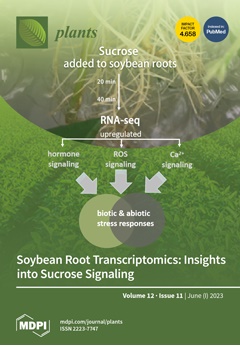Ver ítem
- xmlui.general.dspace_homeCentros Regionales y EEAsCentro Regional Buenos Aires SurEEA BarrowArtículos científicosxmlui.ArtifactBrowser.ItemViewer.trail
- Inicio
- Centros Regionales y EEAs
- Centro Regional Buenos Aires Sur
- EEA Barrow
- Artículos científicos
- Ver ítem
Convergent Adaptation of Multiple Herbicide Resistance to Auxin Mimics and ALS- and EPSPS-Inhibitors in Brassica rapa from North and South America
Resumen
Herbicide-resistant weeds have been identified and recorded on every continent where croplands are available. Despite the diversity of weed communities, it is of interest how selection has led to the same consequences in distant regions. Brassica rapa is a widespread naturalized weed that is found throughout temperate North and South America, and it is a frequent weed among winter cereal crops in Argentina and in Mexico. Broadleaf weed control is based on
[ver mas...]
Herbicide-resistant weeds have been identified and recorded on every continent where croplands are available. Despite the diversity of weed communities, it is of interest how selection has led to the same consequences in distant regions. Brassica rapa is a widespread naturalized weed that is found throughout temperate North and South America, and it is a frequent weed among winter cereal crops in Argentina and in Mexico. Broadleaf weed control is based on glyphosate that is used prior to sowing and sulfonylureas or mimic auxin herbicides that are used once the weeds have already emerged. This study was aimed at determining whether a convergent phenotypic adaptation to multiple herbicides had occurred in B. rapa populations from Mexico and Argentina by comparing the herbicide sensitivity to inhibitors of the acetolactate synthase (ALS), 5-enolpyruvylshikimate-3-phosphate (EPSPS), and auxin mimics. Five B. rapa populations were analyzed from seeds collected in wheat fields in Argentina (Ar1 and Ar2) and barley fields in Mexico (Mx1, Mx2 and MxS). Mx1, Mx2, and Ar1 populations presented multiple resistance to ALS- and EPSPS-inhibitors and to auxin mimics (2,4-D, MCPA, and fluroxypyr), while the Ar2 population showed resistance only to ALS-inhibitors and glyphosate. Resistance factors ranged from 947 to 4069 for tribenuron-methyl, from 1.5 to 9.4 for 2,4-D, and from 2.7 to 42 for glyphosate. These were consistent with ALS activity, ethylene production, and shikimate accumulation analyses in response to tribenuron-methyl, 2,4-D, and glyphosate, respectively. These results fully support the evolution of the multiple- and cross-herbicide resistance to glyphosate, ALS-inhibitors, and auxinic herbicides in B. rapa populations from Mexico and Argentina.
[Cerrar]

Autor
Dominguez-Valenzuela, José Alfredo;
Palma Bautista, Candelario;
Vázquez García, José Guadalupe;
Yanniccari, Marcos;
Gigon, Ramon;
Alcántara de la Cruz, Ricardo;
de Prado, Rafael;
Portugal, João;
Fuente
Plants 12 (11) : 2119. (May 2023)
Fecha
2023-05
Editorial
MDPI
ISSN
2223-7747
Formato
pdf
Tipo de documento
artículo
Palabras Claves
Derechos de acceso
Abierto
 Excepto donde se diga explicitamente, este item se publica bajo la siguiente descripción: Creative Commons Attribution-NonCommercial-ShareAlike 2.5 Unported (CC BY-NC-SA 2.5)
Excepto donde se diga explicitamente, este item se publica bajo la siguiente descripción: Creative Commons Attribution-NonCommercial-ShareAlike 2.5 Unported (CC BY-NC-SA 2.5)


